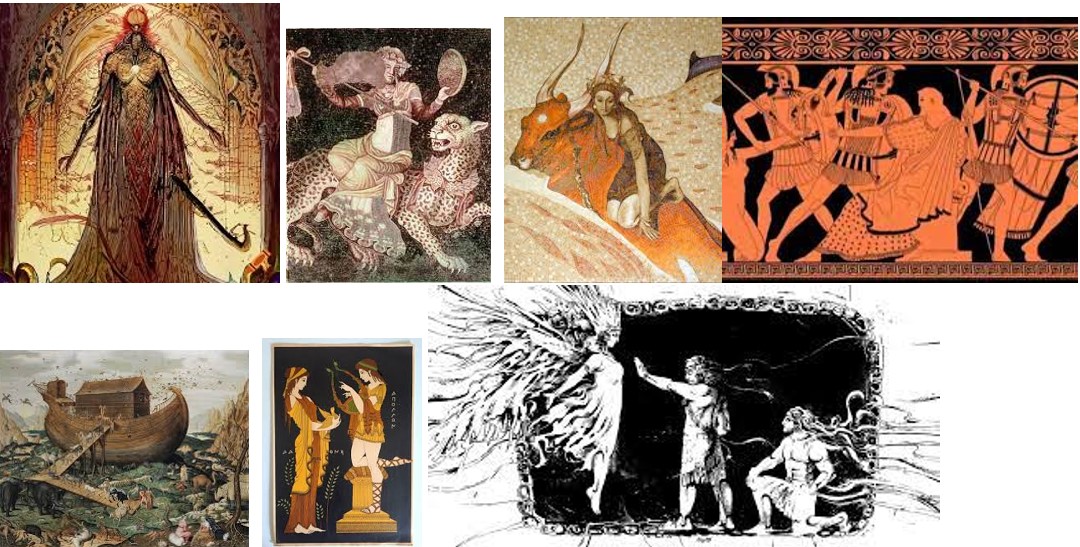Ancient and Classical Art
This unit encompasses art produced in the ancient and classical civilizations of the world. It often includes the following subunits:
- Prehistoric and Paleolithic Art: Art created by early humans, such as cave paintings and sculptures.
- Ancient Near Eastern and Egyptian Art: Art from the Sumerians, Babylonians, Egyptians, and other civilizations in the ancient Near East.
- Greek and Roman Art: The art of ancient Greece and Rome, including sculpture, architecture, and pottery.
Florida Standards
- 912.C.3.6 Discuss how the aesthetics of artwork and utilitarian objects have changed over time.
- 912.S.2.2 Focus on visual information and processes to complete the artistic concept.
Goals
- View mythological art and utilize process to create a narrative style painting.
- Use line, negative/positive space and contrast.
- Focus on visual information and processes to complete the artistic concept.
Targets
- Create a composition with a message that easily reads.
- Analyze and discuss Ancient and Classical art.
- Using various mediums, create a narrative composition.
Concepts/Content
- Symbolism and imagery
- Egyptian art
- Mesopotamian art
- Greek and Roman art
- Mesoamerican
Vocabulary
- Cuneiform
- Ziggurat
- Cylinder seal
- Archaic Period
- Classical Period
- Hellenistic Period
- Idealized
- Doric Order
- Ionic Order
- Corinthian Order
- Polytheism
- Kachina
- Hieratic Scale
- Sacred Geometry
Formative
Peer Critiques, One-on-One Conferences, Sketchbook or Process Journals, Gallery Walks
Summative
Final Art Projects, Written Art Critiques, Artist Statement, Art Appreciation Assessments, Art Showcase or Exhibition, Final Written Reflections
ESE/ESOL
- Use non-linguistic cues, check for understanding and reinforce effort through practice. Make alterations based on lesson and individual student needs.
- Make alterations based on lesson and individual student needs.
- Allowing frequent breaks and allowing content modifications when necessary and for individual student needs.
Scaffold
- Introduction to Ancient and Classical Art:
- Begin by introducing students to the art of ancient and classical civilizations, focusing on the themes, symbols, and styles commonly found in these artworks.
- Mythological or Historical Research:
- Have students choose a mythological or historical narrative from the ancient world. Encourage them to research the chosen story to understand its characters, events, and significance.
- Composition and Sketching:
- Instruct students to sketch a composition that tells a part of the chosen narrative. They should consider the visual elements from ancient and classical art that can be incorporated, such as symmetry, stylized figures, and hieratic scale.
- Painting Process:
- Provide students with the materials needed for painting. They should use acrylic or tempera paints to create their 2D artwork. Encourage them to pay attention to color choices, style, and symbolism in their paintings.
- Symbolism and Detailing:
- Encourage students to include symbols and details that are relevant to the myth or historical event they are depicting. Discuss how ancient artists used symbolism in their works.
- Texture and Finish:
- Experiment with different techniques to add texture and depth to the artwork. Students can use brushstrokes or layering to create a tactile feel.
- Optional Accents:
- If available, students can use gold or silver leaf to add accents to their paintings. This can replicate the use of precious metals in classical art.
- Presentation and Explanation:
- Have each student present their painting to the class, explaining the mythological or historical narrative they depicted, the artistic choices they made, and the symbolism they included.
- Class Exhibition:
Arrange a class exhibition where students can display their mythological narrative paintings. This allows for discussion and peer critique.

